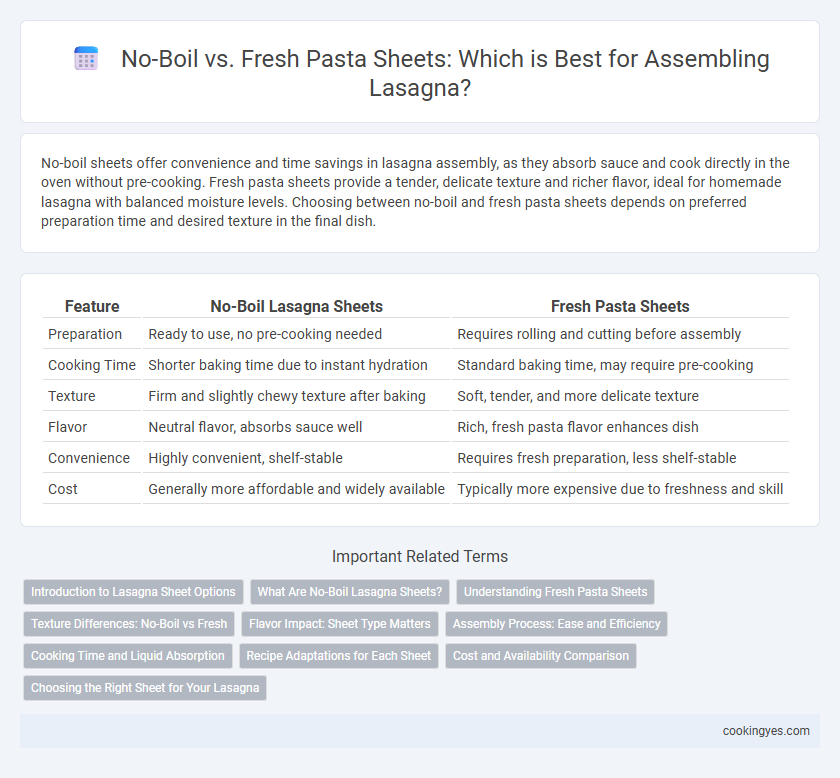No-boil sheets offer convenience and time savings in lasagna assembly, as they absorb sauce and cook directly in the oven without pre-cooking. Fresh pasta sheets provide a tender, delicate texture and richer flavor, ideal for homemade lasagna with balanced moisture levels. Choosing between no-boil and fresh pasta sheets depends on preferred preparation time and desired texture in the final dish.
Table of Comparison
| Feature | No-Boil Lasagna Sheets | Fresh Pasta Sheets |
|---|---|---|
| Preparation | Ready to use, no pre-cooking needed | Requires rolling and cutting before assembly |
| Cooking Time | Shorter baking time due to instant hydration | Standard baking time, may require pre-cooking |
| Texture | Firm and slightly chewy texture after baking | Soft, tender, and more delicate texture |
| Flavor | Neutral flavor, absorbs sauce well | Rich, fresh pasta flavor enhances dish |
| Convenience | Highly convenient, shelf-stable | Requires fresh preparation, less shelf-stable |
| Cost | Generally more affordable and widely available | Typically more expensive due to freshness and skill |
Introduction to Lasagna Sheet Options
No-boil sheets simplify lasagna assembly by eliminating pre-cooking, absorbing sauce during baking to achieve tender layers while saving preparation time. Fresh pasta sheets, crafted from egg-rich dough, offer a delicate texture and richer flavor, requiring brief pre-cooking or direct layering with sufficient sauce to prevent drying. Choosing between no-boil and fresh pasta sheets impacts cooking time, texture, and flavor intensity in the final lasagna dish.
What Are No-Boil Lasagna Sheets?
No-boil lasagna sheets are pre-cooked pasta sheets designed to save preparation time by eliminating the need to boil before layering. These sheets are thinner and absorb moisture from sauces during baking, ensuring a tender texture without overcooking. Compared to fresh pasta sheets, no-boil sheets offer convenience and consistency, making them ideal for quick and easy lasagna assembly.
Understanding Fresh Pasta Sheets
Fresh pasta sheets, made from a simple dough of flour, eggs, and water, offer a tender texture and rich flavor that enhances lasagna authenticity. Their higher moisture content requires careful handling to prevent tearing during assembly and typically benefit from light pre-cooking or thorough sauce coverage to ensure even cooking in the oven. Compared to no-boil sheets, fresh pasta integrates seamlessly with layers, creating a cohesive structure and absorbing sauce flavors more effectively for a balanced lasagna experience.
Texture Differences: No-Boil vs Fresh
No-boil lasagna sheets absorb sauce during baking, resulting in a softer, tender texture that seamlessly melds with other ingredients. Fresh pasta sheets offer a more delicate, pliable bite with a slightly elastic mouthfeel, enhancing the lasagna's overall richness. Choosing between no-boil and fresh pasta sheets influences the final dish's texture, with no-boil sheets providing ease and softness, while fresh sheets deliver a nuanced, artisanal chew.
Flavor Impact: Sheet Type Matters
No-boil sheets absorb sauce during baking, enhancing flavor integration but can sometimes result in a softer texture compared to fresh pasta sheets. Fresh pasta sheets offer a more pronounced wheat flavor and a firmer bite, contributing to a more textured and artisanal lasagna experience. Choosing between no-boil and fresh pasta sheets significantly influences the depth of flavor and overall mouthfeel in the final dish.
Assembly Process: Ease and Efficiency
No-boil lasagna sheets significantly streamline the assembly process by eliminating the need for pre-cooking, reducing preparation time and minimizing mess. Fresh pasta sheets offer a tender texture and authentic flavor but require careful handling and pre-cooking or par-cooking to prevent tearing. For efficient lasagna assembly, no-boil sheets provide consistent layering and ease of use, ideal for quick meals and large batches.
Cooking Time and Liquid Absorption
No-boil lasagna sheets reduce overall cooking time by softening directly in the sauce without pre-cooking, absorbing excess liquid to create a perfectly tender texture. Fresh pasta sheets require minimal cooking time and absorb less liquid, resulting in a firmer bite and a more delicate lasagna structure. Choosing between no-boil and fresh pasta sheets depends on desired texture and the moisture level of the sauce during assembly.
Recipe Adaptations for Each Sheet
No-boil lasagna sheets require increased sauce and liquid to ensure proper hydration during baking, making it essential to adjust the recipe by adding extra moisture-rich ingredients such as tomato sauce or bechamel. Fresh pasta sheets benefit from reduced cooking times and less sauce, as their higher moisture content facilitates quicker softening and flavor absorption. Adapting recipes for each type of sheet guarantees optimal texture and prevents dryness or overcooking in the final lasagna dish.
Cost and Availability Comparison
No-boil lasagna sheets are generally more affordable and widely available in most grocery stores, offering convenience without the need for pre-cooking. Fresh pasta sheets, while pricier and often found in specialty or Italian markets, provide superior texture and flavor that many chefs prefer for premium lasagna. Choosing between them depends on budget constraints and access to fresh pasta, balancing cost-effectiveness with culinary quality.
Choosing the Right Sheet for Your Lasagna
No-boil sheets are designed for convenience, absorbing sauce during baking to soften perfectly without pre-cooking, making them ideal for quick lasagna assembly. Fresh pasta sheets offer superior texture and flavor, delivering a tender bite and slightly chewy consistency that elevates traditional recipes but require precooking or careful handling to prevent sogginess. Selecting the right sheet depends on your priorities: no-boil sheets save time and simplify preparation, while fresh pasta sheets provide authentic taste and a refined lasagna experience.
No-Boil Sheets vs Fresh Pasta Sheets for Lasagna Assembly Infographic

 cookingyes.com
cookingyes.com